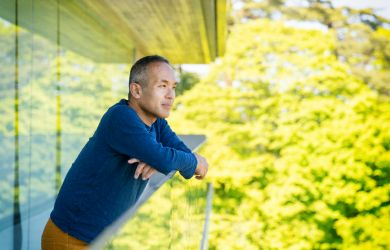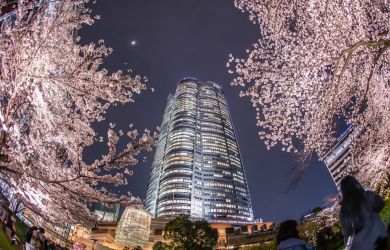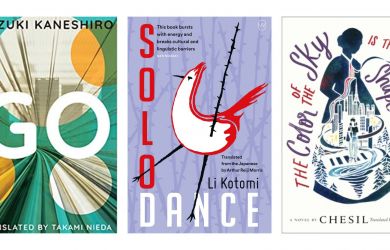
July 14, 2011
Find Mystic Love in Shimane
One of Japan’s oldest shrines offers a world of connections
By Metropolis
Originally published on metropolis.co.jp on July 2011

On the west coast of Honshu lies Shimane, the second least-populated prefecture of Japan, and a famed mystical area with a huge significance in Shinto mythology. Nowhere is this more apparent than at the magnificent Izumo Taisha Grand Shrine. Located in Izumo City around 30km from Matsue, this officially designated National Treasure will connect you with an ancient universe of spirituality, and offer you many other connections besides.
The term Enmusubi refers to the deity enshrined there, Okuninushi no mikoto, who is known as the creator of Japan and the god of affinity, or enmusubi (“the ties that bind us together”). Shinto legend has it that the Izumo shrine was a present from the Sun Goddess Amaterasu to Okuninushi. The sacred nature of the place is hinted at by the name of the tenth month in the lunar calendar; called kannazuki in the rest of Japan (“the month of no gods”), in the Izumo region it is referred to as kamiarizuki (“the month of the gods”).
Local legend has it that during this month all the deities from around Japan make the trip out to Izumo Taisha to discuss what connections people are going to have this year. So it’s probably a good place to put a word in. The ukiyo-e, or woodblock print (pictured above), depicts the gods riding to the Izumo Taisha in order to connect name tags with string. In fact, even now many couples travel there to get married, as well as single people looking for love.
The Grand Shrine is one of the most ancient in Japan, and though the date of construction has not been defined, it bears record in the two oldest chronicles of Japan—the Kojiki and Nihon Shoki—and was described as the tallest building way back in the year 950. As well as mythical importance, Izumo Taisha also has immense architectural significance, with a whole style—taisha zukuri—based on the main hall of the Shrine. In 2000, large pillars were discovered, revealing that the building used to be much taller than it is now. Nevertheless, the hallowed structure still exerts a powerful spiritual presence on visitors today.
Izumo Taisha is easily accessed by train from Matsue on the Ichibata line.
Discover, as part of the Izumo Taisha compound, other spiritual, love-filled sights designated as important.
www.kankou-shimane.com/en
http://www.kamiari.com/en

Yaegaki Shrine
Why bother with a matchmaking service when you can pay a trip to Yaegaki Shrine? Naturally, many ladies pray here for marriage partners, good marital relations, children and family health. But if prayers don’t satisfy, owing to their lack of any concrete information, the solution is to be found at kagami no ike (“mirror pond”). Simply float a piece of paper on the water’s surface and place a coin on top. The faster it sinks, the earlier you will meet the tall, dark stranger. No cheating by throwing it really hard.
The shrine was mythically created as a marital bower for Princess Inada and Susano no mikoto, the god of sea and storms, after he’d freed her from an eight-headed serpent who’d eaten all her sisters. See the Princess herself on a Japanese cypress painting here, known as the oldest shrine wall mural in Japan.
www.shinbutsu.jp/english/45.html

Tamatsukuriyu Shrine
One guardian enshrined at this peaceful and tranquil site is that of magatama, the comma-shaped gem, or curved bead, that was used as jewelry and offerings in ancient times and which spread throughout the whole of Japan as a tradition. Tamatsukuri was the main producer of magatama and has always been famed for its onsen and relationship towards magical or health-giving stones. In fact, the other guardian enshrined here is the guardian of the onsen, which you can access just three minutes away from the shrine to bathe your worldly worries away.
Recently, a natural stone called negai ishi (“wishing stone”) has become a very popular “power spot.” It is said to have been born from the mountain, and over 50,000 associated lucky charms were given out in 2010. The local onsen is also famed for its rejuvenating effect on skin.
www.tama-onsen.jp/negaiishi (Japanese Only)

Adachi MusEum of Art
At the Adachi Museum of Art’s Jurakuan tea room, there is a golden kama, or metal pot. When you drink matcha from it, you can reportedly gain happiness and prolong your life. Not a bad addition to Adachi’s famous collection of contemporary Japanese paintings—including 1,500 of the most renowned post-Meiji paintings around. But the gallery is as famed for its gardens as for its objets d’art. Annually ranked number one in America’s Journal of Japanese Gardening and awarded three stars by Michelin Green Guide Japan, the gardens were created by the museum’s founder, who traveled all across Japan collecting pine trees and rocks for the landscape. The 165,000 m2 of exquisite grounds offer a breathtaking view that changes dramatically season by season.

Matsue Castle
Matsue is one of 12 Japanese castles that still remain in their original wooden form. Constructed in 1607, it has lasted through fire, war and natural calamities. Though its interior buildings were destroyed in 1875, the majestic tower remains standing. An optical illusion, it seems to be five levels from the outside but is actually six on the inside. The somber momoyama-style of the building will send an historical chill down your spine. In the spring, the grounds of the castle explode in sakura blossoms. It is said that if you touch the famous heart-shaped wood grain with your lover, your relationship will grow stronger.
www.kankou-shimane.com/en/matsue/spot/index.html#matsuecastle

Lake Shinji Pleasure Boat
If you have ever wondered why drawings of the sun are colored red in Japan, take a sunset cruise on Lake Shinji and you will wonder no more. The blood red orb descending dramatically behind the only island, Yome ga shima, is the typical postcard of the area, but nothing compares to witnessing it in person, with the soft lapping of the water at the boat to provide a soundtrack. The seventh largest lake in Japan supports plenty of tasty delicacies, such as sea bass and shijimi clams, that can be enjoyed in the area. Ring the boat’s enmusubi bell for more happy karma.
www.kankou-shimane.com/en/matsue/spot/index.html#lakeshinji

Enmusubi Sweet
If you have a sweet tooth, and a propensity towards saccharine wishes of love and happiness, you’ll be in the right place in Shimane. The region is famed for its sugary culinary delights, which include some local specialties. Even some original heart-shaped burgers, with slightly sweet buns made from local wheat and wild yeast, are fantastically popular with the young women who frequent the zone. You have probably tasted the Japanese favorite zenzai, a soup of rice cake and red beans, but it will never taste as sumptuous as here, in the very place it was invented.





